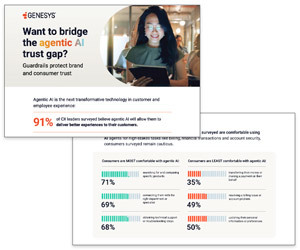In today’s digital world, chatbots are essential for 24/7 customer support, but only if they perform well. Customers expect fast, accurate, and personalised responses, and poorly optimised bots can harm satisfaction and loyalty.
That’s why we have provided eight practical ways to improve contact centre chatbots and ensure they deliver a seamless, efficient, and customer-friendly experience.
8 Proven Ways to Improve Contact Centre Chatbots Today
1. Put an Escalation Path in Place

Where chatbots add most value for businesses is in answering routine questions quickly. If the questioning becomes more complex, the business needs to have an option to escalate the interaction to a human advisor.
That advisor should be able to pick up the thread of what has gone before and, where necessary, switch the call from a chat window to a voice interaction.
Many Modern AI chatbots are capable of handling more complex queries than before, thanks to advancements in language models and contextual understanding. Escalation is still important for highly sensitive or nuanced issues, where the human touch can make a difference.
It’s also important that businesses put sufficient resources in place to manage any escalations, ensure customers’ waiting times are kept to a minimum and that appropriate service level agreements are implemented and always met.
If you want to find out how to design an escalation path, read our article: How to Design an Escalation Matrix for Call Centre Agents
2. Keep Feeding Chatbots With New Information
While chatbots do fulfil an invaluable role within many contact centres, businesses need to realise that implementing and then operating them can be a major commitment.
Contrary to popular belief, chatbots are not cheap to run, they can be time-consuming to maintain and they need to be regularly exposed to new data and information to stay current.
If an organisation neglects its chatbots, fails to provide them with sufficient data, educate them or give them what they need to learn and grow, those chatbots will become redundant, in the same way that a website that has not been updated will.
Fortunately, many modern chatbots now incorporate self-learning mechanisms, making it easier to adapt to new information and reduce the need for constant manual updates. However, oversight and periodic updates remain necessary. So, the lesson for businesses is clear: keep your chatbots fed at all times.
Contributed by: Jeremy Payne, Group VP Marketing & Alliances Enghouse Interactive
For more information on implementing chatbots within your contact centre, read our article: Chatbots: How Your Business SHOULD Be Using Them – With Examples
3. Make Chatbots More Empathetic

Chatbots are usually efficient and a tremendous help in a variety of cases. But, as with any other automated systems, customers engaging with a chatbot can sometimes feel a lack of empathy or find it a struggle to express their emotions during conversations.
As Genesys recommend, contact centres should aim to make chatbots much more empathetic. They need the
- Ability to capture customer sentiment throughout the conversations, without explicitly asking (implicit measure)
- Ability to adapt the conversation flow and the responses to sentiments
- Ability to explicitly ask at the end of the conversation how the customer feels (explicit measure)
- Ability to compare implicit and explicit measures to improve sentiment capture over time
Today, AI models are better equipped with advanced sentiment analysis and contextual understanding, allowing chatbots to respond with more nuanced and appropriate empathy in real time.
By doing this, the contact centre enables the tuning teams to figure out the emotional circumstances where the chatbots are not performing well and keep training them to exhibit satisfactory behaviour!
Contributed by: Remy Claret, on behalf of Genesys
4. Use Them to Collect Information in the Initial Part of Conversations

The secret to improving Customer Satisfaction of chatbots is knowing when and how to implement them.
If the contact centre has already successfully implemented self-service, and improved CSAT by doing so, then it could be the right time to add bots to the mix.
Start with existing live chat offerings, or social media messaging applications – like Facebook Messenger, and then introduce bots.
Once bots have been introduced, use them to automate the repetitive tasks of collecting information at the start of any dialogue and, ultimately, directing the caller to another self-service option or a live advisor.
Modern chatbots can also integrate seamlessly with CRM systems to pre-populate customer data, making interactions even smoother and more efficient.
Contributed by: Mashud Ahmed, Product Manager, Puzzel
5. Use Natural Language Processing (NLP) to Make Chatbots Seem Friendlier

Make your chatbot friendlier without being intrusive. It is important to strike an appropriate tone for your audience.
Through Natural Language Processing (NLP), the system learns to recognise real language. This engagement with language allows the software to utilise data to provide customers with personalised information.
Also, the software is able to analyse the customer’s tone, allowing the chatbot to interact and engage conversationally.
In many cases, customers have felt that they are receiving correspondence from a real person, rather than robotic software. With this more colloquial tone, the software will extend the brand into an interactive experience for consumers.
The double benefit of this for the company is that transcripts of conversations can be easily managed and analysed.
Providing further customer insights, the software allows the company to understand what type of customers are visiting their website, what they are looking for and recurring issues that need resolving.
Contributed by: Susannah Richardson, VP Global Campaigns, IFS
6. Use Interaction Analytics to Make Chatbots More Conversational

The way that people communicate on the phone is different from the way they communicate using a text message, chat, or email.
It is therefore important to be able to identify these differences and then “coach” chatbots accordingly, to ensure customers feel satisfied with the interaction and its outcome.
The goal is to make these chatbots use the same communications approach as a human when carrying on a conversation.
Today, AI-driven interaction analytics tools can automatically identify communication patterns and adjust chatbot responses dynamically, reducing the need for manual coaching. This ensures that the differences between the preferred approaches on different channels are understood to as great a degree as possible.
Contributed by: Frank Sherlock, VP International, CallMiner
7. Leverage Data

With Gartner predicting that the vast majority of customer interactions will be powered by chatbots in 2020, it is more important than ever for organisations to step up their game in terms of learning from customer interactions.
Modern technologies such as machine learning and neural networks can help make use of the data, learn from it and use it to inform how a chatbot should react to new interaction types.
Real-time analytics and AI-powered insights help chatbots learn continuously and improve their responses without significant manual intervention.
Using technologies like this will reduce the workload for advisors, leaving them the time to dedicate attention to more complex, nuanced and human issues.
8. Understand Their Limitations
While bots can be “trained” in empathy and friendliness, customers will always appreciate the human touch when dealing with more complex queries, where empathy and understanding can make all the difference.
While chatbots are well placed to deal with the most common issues, like package tracking and information requests, there are issues that still need the human touch, like bespoke product advice.
We see chatbots working best when they’re working hand in hand with advisors. Dealing with gigantic quantities of low-complexity issues is where chatbots shine, particularly when they’re empowered to seamlessly hand off cases to an advisor when needed.
Take the holiday shopping season, for example – Black Friday, Cyber Monday, Christmas – the time when retailers are at their busiest. Research recently conducted by Zendesk found that ticket volumes can increase by as much as 42% over the holidays. It’s at times like these when chatbots can really be a good addition to a contact centre.
Contributed by: Prelini Udayan-Chiechi, on behalf of Zendesk
For more information on chatbots and how to improve them, read these articles next:
- F*** This! How to Make Sure Your Chatbots Don’t Swear at Customers
- How to Measure Chatbot Performance
- Chatbots: How Your Business SHOULD Be Using Them – With Examples
Author: Charlie Mitchell
Reviewed by: Hannah Swankie
Published On: 12th Mar 2018 - Last modified: 19th Aug 2025
Read more about - Technology, Artificial Intelligence (AI), CallMiner, Chatbots, Customer Satisfaction (CSAT), Enghouse Interactive, Frank Sherlock, Genesys, IFS, Jeremy Payne, Mashud Ahmed, Puzzel, Susannah Richardson, Zendesk





















